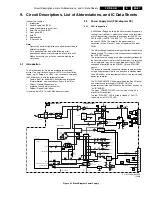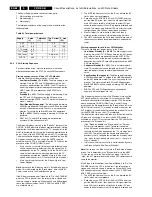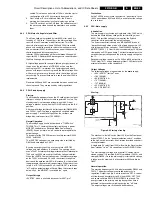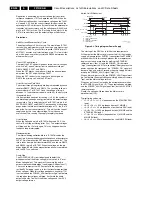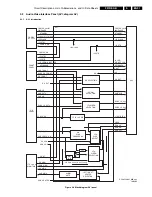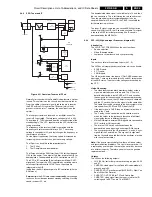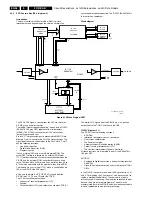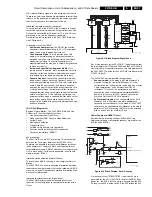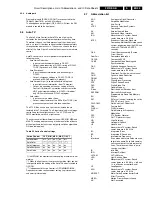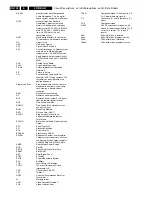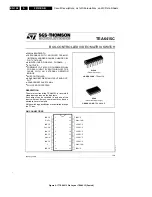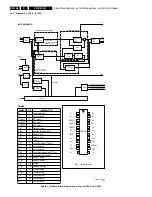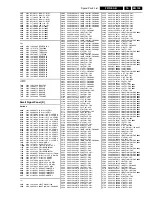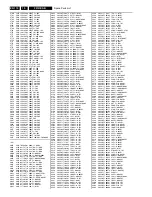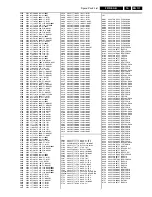
Circuit Descriptions, List of Abbreviations, and IC Data Sheets
EN 99
F21RE AB
9.
9.5.2
Audio path
Front audio inputs (SNDL/R_FRONT) are connected to the
TEA6422 (item 7810) on the AV-Interface.
The headphone output signal (DS_AUDIO_L/R) from the DW
module is routed to the front panel.
9.6
Auto TV
The Auto Picture Control (or AutoTV) aims at giving the
customer the best possible picture performance at any time.
Therefore, it does a real time processing of the video signal
and, as a result, it decides to adapt several video parameters
throughout the whole chassis. The user can choose the total
effect of the Auto Picture Control on the screen via the remote
control.
AutoTV consists of a set of algorithms that perform the
following tasks:
•
Auto Noise Reduction:
–
Input: noise measurement done in PICNIC.
–
Output: noise reduction of PICNIC, coring of PICNIC,
TOPIC (if present), or EAGLE (if present).
•
Auto Sharpness:
–
Input: steepness information and band energy in
PICNIC.
–
Output: sharpness settings in PICNIC, TOPIC (if
present), or EAGLE module (if present).
•
Auto Ambient Light (in combination with histogram):
–
Input: light sensor information (from TV monitor).
–
Output: is depending on the user setting of Active
Control. If "maximum", saturation and contrast of the
HOP and histogram settings in PICNIC. If "medium",
only HOP saturation and PICNIC histogram.
•
Auto colour:
–
Input: user smart mode choice.
–
Output: colour features of the EAGLE (or TOPIC), like
green enhancement and skin tone correction.
The FTV E-Box has no own light sensor, instead they is
featured in the TV monitors. The E-box is involved in the image
control loop for these light sensors. The 42" F19D and 50”
FM25 monitor do not have a light sensor.
The user can select four different settings: OFF, MIN, MED and
MAX. The setting does not change the amount of the influence
of the algorithms on the screen, but partly switches algorithms
ON (see table below).
Table 9-5 Active Control settings
(*) In MEDIUM, the monitor contrast coupling of ambient is not
working.
(**) When the light sensor is not present, ambient light control
is not possible and the setting of the AutoTV button is limited to
OFF/ON.
(***) Independent of Active Control is OFF/MIN/MED/MAX.
Dependent of colour enhancement setting (in picture menu)
and smart picture mode.
9.7
Abbreviation list
ADC
Analogue to Digital Converter
AM
Amplitude Modulation
AP
Asia Pacific
ATSC
Advance Television Systems
Committee
AV
External Audio/Video
AVI
Audio and Video Interface
B/G
Monochrome TV system. Sound
carrier distance is 5.5 MHz
BTSC
Broadcast Television Standard
Committee. Multiplex FM stereo sound
system, originating from the USA and
used in LATAM and AP-NTSC
countries
CBA
Circuit Board Assembly (Printed
Circuit Board)
ComPair
Computer aided rePair
CSYNC
Composite SYNC
CVBS
Composite Video Blanking and
Synchronization
DAC
Digital to Analogue Converter
D/K
Monochrome TV system. Sound
carrier distance is 6.5 MHz
DFU
Directions For Use: owner's manual
DNR
Dynamic Noise Reduction
DRAM
Dynamic RAM
DSP
Digital Signal Processing
DTS
Digital Theatre Sound
DVD
Digital Video Disc
DW
Double Window
E-box
Electronic box (Receiver box)
EEPROM
Electrically Erasable and
Programmable Read Only Memory
EU
EUrope
EXT
EXTernal (source); entering the set by
SCART or cinch (jack)
FALCONIC
Field And Line CONverter IC
FBX
Feature BoX
FLASH
FLASH memory
FM
Field Memory or Frequency
Modulation
FSP
FTV System Protocol
FTV
Flat TV (plasma screen)
HD
High Definition
HFB
Horizontal FlyBack
HP
HeadPhone
I
Monochrome TV system. Sound
carrier distance is 6.0 MHz
I2C
Integrated IC bus
I2S
Integrated IC Sound bus
IF
Intermediate Frequency
Interlaced
Scan mode where two fields are used
to form one frame. Each field contains
half the number of the total amount of
lines. The fields are written in "pairs",
causing line flicker.
IR
Infra Red
IRQ
Interrupt ReQuest
LATAM
LATin AMerica
LED
Light Emitting Diode
L/L'
Monochrome TV system. Sound
carrier distance is 6.5 MHz. L' is Band
I, L is all bands except for Band I
LS
LoudSpeaker
M/N
Monochrome TV system. Sound
carrier distance is 4.5 MHz
MOSFET
Metal Oxide Semiconductor Field
Effect Transistor
MPEG
Motion Pictures Experts Group
NC
Not Connected
Active Control
OFF MIN MED MAX ON (**)
Auto Ambient
off
off
on (*) on
off
Auto Color (***) (***) (***)
(***)
(***)
Auto Histogram
on
on
on
on
on
Auto Sharpness
on
on
on
on
on
Auto Noise
off
on
on
on
on
Summary of Contents for F21RE
Page 7: ...Directions for Use EN 7 F21RE AB 3 3 Directions for Use ...
Page 8: ...Directions for Use EN 8 F21RE AB 3 ...
Page 9: ...Directions for Use EN 9 F21RE AB 3 ...
Page 10: ...Directions for Use EN 10 F21RE AB 3 ...
Page 11: ...Directions for Use EN 11 F21RE AB 3 ...
Page 12: ...Directions for Use EN 12 F21RE AB 3 ...
Page 13: ...Directions for Use EN 13 F21RE AB 3 ...
Page 14: ...Directions for Use EN 14 F21RE AB 3 ...
Page 15: ...Directions for Use EN 15 F21RE AB 3 ...
Page 16: ...Directions for Use EN 16 F21RE AB 3 ...
Page 17: ...Directions for Use EN 17 F21RE AB 3 ...
Page 18: ...Directions for Use EN 18 F21RE AB 3 ...
Page 19: ...Directions for Use EN 19 F21RE AB 3 ...
Page 20: ...Directions for Use EN 20 F21RE AB 3 ...
Page 21: ...Directions for Use EN 21 F21RE AB 3 ...
Page 22: ...Directions for Use EN 22 F21RE AB 3 ...
Page 23: ...Directions for Use EN 23 F21RE AB 3 ...
Page 24: ...Directions for Use EN 24 F21RE AB 3 ...
Page 25: ......
Page 114: ...Revision List EN 114 F21RE AB 11 11 Revision List First release ...



